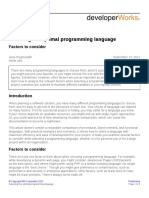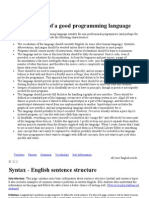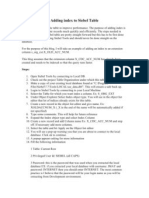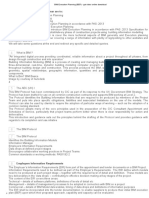How To Start A Programming Language
Uploaded by
Jose Rafael Ripoll ParejoHow To Start A Programming Language
Uploaded by
Jose Rafael Ripoll ParejoHow to start a programming language?
Starting a programming language can be a complex and time-consuming task. Here are some
general steps to help you get started:
Choose a programming language to create your language: You will need to choose a
programming language to write your new language in. Most new programming languages are
written in either C or C++.
Define the purpose of your programming language: You need to determine what your
programming language will be used for. Will it be a general-purpose language, or will it be
designed for a specific task or problem domain?
Design the syntax of your programming language: The syntax is the set of rules that govern how
programs written in your language will be structured. You need to decide how variables will be
declared, how statements will be structured, and how control structures (like loops and
conditionals) will work.
Create a lexer and parser: A lexer takes the source code of a program and breaks it down into
individual tokens. A parser then takes those tokens and creates a syntax tree that represents the
structure of the program.
Define the semantics of your programming language: The semantics are the rules that
determine how the program will behave when it is run. This includes things like how variables
are assigned and how functions are called.
Write a compiler or interpreter: You will need to create a program that can take the source code
of programs written in your language and translate it into machine code that can be executed
on a computer. This can be done either through compilation or interpretation.
Test your programming language: You will need to test your language thoroughly to ensure that
it works as intended and is free from bugs and errors.
Starting a programming language can be a challenging undertaking, and it requires a significant
amount of time and effort. It is recommended that you have a strong understanding of
programming concepts and experience with programming languages before attempting to
create your own language.
Research existing programming languages: Before starting a new programming language, it is
important to research existing programming languages to identify their strengths and
weaknesses. This will help you to design a language that is unique and fills a gap in the market.
Identify your target audience: Consider who your programming language is intended for. Is it for
hobbyists or professional developers? Will it be used for a specific industry or application?
Understanding your target audience will help you to design a language that meets their needs.
Create a language specification: A language specification is a document that describes the
syntax and semantics of your programming language. This document is important for anyone
who wants to use or contribute to your language.
Build a community: Building a community of developers and users around your programming
language is critical for its success. This can be done through social media, forums, and open-
source contributions.
Consider compatibility: If your programming language is intended to be used alongside other
languages, you should consider compatibility with those languages. This may involve creating
libraries or other tools that allow developers to use your language in conjunction with others.
You might also like
- Characteristics of A Good Programming Language100% (1)Characteristics of A Good Programming Language4 pages
- Dokumen - Pub - C Programming For Beginners Crash Course Ultimate Edition 9781542764803 154276480750% (2)Dokumen - Pub - C Programming For Beginners Crash Course Ultimate Edition 9781542764803 154276480743 pages
- Introduction To Programming Languages and Tools of The TradeNo ratings yetIntroduction To Programming Languages and Tools of The Trade9 pages
- Chapter One: Introduction Programming LanguagesNo ratings yetChapter One: Introduction Programming Languages18 pages
- CSC 413 Organisation of Programming Language 2021No ratings yetCSC 413 Organisation of Programming Language 202141 pages
- Programming: Take An Introductory Course in One (Or Both) of The Following DisciplinesNo ratings yetProgramming: Take An Introductory Course in One (Or Both) of The Following Disciplines28 pages
- Integrative Programming Technology - Applications VS Script WritingNo ratings yetIntegrative Programming Technology - Applications VS Script Writing10 pages
- Four Steps To Take Before Writing A Computer Program: 1. Identify The ProblemNo ratings yetFour Steps To Take Before Writing A Computer Program: 1. Identify The Problem7 pages
- Lesson 1 Introduction to Basic Progrogramming ConceptsNo ratings yetLesson 1 Introduction to Basic Progrogramming Concepts31 pages
- How To Write A Master's Thesis in Computer ScienceNo ratings yetHow To Write A Master's Thesis in Computer Science6 pages
- Week1-Introduction To Programming ConceptsNo ratings yetWeek1-Introduction To Programming Concepts5 pages
- Hla PR Ogramming Style Guidelines Appendix CNo ratings yetHla PR Ogramming Style Guidelines Appendix C38 pages
- Assignment Software Design and DevelopmentNo ratings yetAssignment Software Design and Development28 pages
- Form 2: The Program Development Life CycleNo ratings yetForm 2: The Program Development Life Cycle3 pages
- Computer Programming For Beginners. Fundamentals of Programming100% (2)Computer Programming For Beginners. Fundamentals of Programming146 pages
- IT Technologies Cheet Sheet For RecruitersNo ratings yetIT Technologies Cheet Sheet For Recruiters18 pages
- Complete Download Understanding Programming Languages 1st Edition Cliff B. Jones PDF All ChaptersNo ratings yetComplete Download Understanding Programming Languages 1st Edition Cliff B. Jones PDF All Chapters55 pages
- Comparison Among Greedy, Divide & Conquer andNo ratings yetComparison Among Greedy, Divide & Conquer and8 pages
- WGSN Fashion Forecast AW1415 Rendering Reality PDFNo ratings yetWGSN Fashion Forecast AW1415 Rendering Reality PDF25 pages
- ANSYS Offshore Solutions What You Will Learn AboutNo ratings yetANSYS Offshore Solutions What You Will Learn About3 pages
- PARAM - Wikipedia, The Free Encyclopedia PDFNo ratings yetPARAM - Wikipedia, The Free Encyclopedia PDF6 pages
- Reorder Point Planning Forecast-Based Planning Time-Phased PlanningNo ratings yetReorder Point Planning Forecast-Based Planning Time-Phased Planning6 pages
- CS609 CURRENT MIDTERM SOLVED SUBJECTIVE by JUNAIDNo ratings yetCS609 CURRENT MIDTERM SOLVED SUBJECTIVE by JUNAID11 pages
- Vsa-Student Registration System in The Azure Cloud100% (2)Vsa-Student Registration System in The Azure Cloud25 pages
























































































